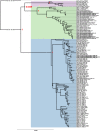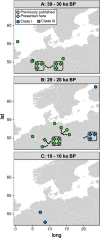Central European Woolly Mammoth Population Dynamics: Insights from Late Pleistocene Mitochondrial Genomes
- PMID: 29255197
- PMCID: PMC5735091
- DOI: 10.1038/s41598-017-17723-1
Central European Woolly Mammoth Population Dynamics: Insights from Late Pleistocene Mitochondrial Genomes
Abstract
The population dynamics of the Pleistocene woolly mammoth (Mammuthus primigenius) has been the subject of intensive palaeogenetic research. Although a large number of mitochondrial genomes across Eurasia have been reconstructed, the available data remains geographically sparse and mostly focused on eastern Eurasia. Thus, population dynamics in other regions have not been extensively investigated. Here, we use a multi-method approach utilising proteomic, stable isotope and genetic techniques to identify and generate twenty woolly mammoth mitochondrial genomes, and associated dietary stable isotopic data, from highly fragmentary Late Pleistocene material from central Europe. We begin to address region-specific questions regarding central European woolly mammoth populations, highlighting parallels with a previous replacement event in eastern Eurasia ten thousand years earlier. A high number of shared derived mutations between woolly mammoth mitochondrial clades are identified, questioning previous phylogenetic analysis and thus emphasizing the need for nuclear DNA studies to explicate the increasingly complex genetic history of the woolly mammoth.
Conflict of interest statement
The authors declare that they have no competing interests.
Figures


Similar articles
-
Complete Columbian mammoth mitogenome suggests interbreeding with woolly mammoths.Genome Biol. 2011;12(5):R51. doi: 10.1186/gb-2011-12-5-r51. Epub 2011 May 31. Genome Biol. 2011. PMID: 21627792 Free PMC article.
-
The evolutionary and phylogeographic history of woolly mammoths: a comprehensive mitogenomic analysis.Sci Rep. 2017 Mar 22;7:44585. doi: 10.1038/srep44585. Sci Rep. 2017. PMID: 28327635 Free PMC article.
-
[Structural and Functional Organization of the Mitochondrial DNA Control Region in the Woolly Mammoth (Mammuthus primigenius)].Mol Biol (Mosk). 2019 Jul-Aug;53(4):627-637. doi: 10.1134/S0026898419040062. Mol Biol (Mosk). 2019. PMID: 31397436 Russian.
-
Cloning the mammoth: a complicated task or just a dream?Adv Exp Med Biol. 2014;753:489-502. doi: 10.1007/978-1-4939-0820-2_19. Adv Exp Med Biol. 2014. PMID: 25091921 Review.
-
The mastodon mitochondrial genome: a mammoth accomplishment.Trends Genet. 2008 Feb;24(2):49-52. doi: 10.1016/j.tig.2007.11.005. Epub 2008 Jan 14. Trends Genet. 2008. PMID: 18192067 Review.
Cited by
-
Origin and dispersal history of Hepatitis B virus in Eastern Eurasia.Nat Commun. 2024 Apr 5;15(1):2951. doi: 10.1038/s41467-024-47358-6. Nat Commun. 2024. PMID: 38580660 Free PMC article.
-
Micro Methods for Megafauna: Novel Approaches to Late Quaternary Extinctions and Their Contributions to Faunal Conservation in the Anthropocene.Bioscience. 2019 Nov 1;69(11):877-887. doi: 10.1093/biosci/biz105. Epub 2019 Oct 2. Bioscience. 2019. PMID: 31719710 Free PMC article.
-
Ancient DNA of narrow-headed vole reveal common features of the Late Pleistocene population dynamics in cold-adapted small mammals.Proc Biol Sci. 2023 Feb 22;290(1993):20222238. doi: 10.1098/rspb.2022.2238. Epub 2023 Feb 15. Proc Biol Sci. 2023. PMID: 36787794 Free PMC article.
-
Stable isotopes reveal patterns of diet and mobility in the last Neandertals and first modern humans in Europe.Sci Rep. 2019 Mar 14;9(1):4433. doi: 10.1038/s41598-019-41033-3. Sci Rep. 2019. PMID: 30872714 Free PMC article.
-
Signals of positive selection in mitochondrial protein-coding genes of woolly mammoth: Adaptation to extreme environments?Ecol Evol. 2019 May 9;9(12):6821-6832. doi: 10.1002/ece3.5250. eCollection 2019 Jun. Ecol Evol. 2019. PMID: 31380018 Free PMC article.
References
-
- Enk, J. et al. Mammuthus population dynamics in Late Pleistocene North America: Divergence, phylogeography, and introgression. Front. Ecol. Evol. 4 (2016).
Publication types
MeSH terms
Substances
LinkOut - more resources
Full Text Sources
Other Literature Sources

